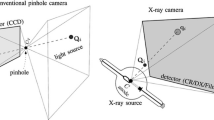Abstract
The accuracy of coordinate transformation from a CT image to a stereotactic frame was investigated for stereotactic systems using a localisation frame and matrix-based coordinate transformation. The main source of error influencing calculation was input data, due to inaccurate calculation of the centres of the rods of the localisation frame in the CT image, and the propagation of this input error during subsequent matrix calculation. Systemic errors during matrix calculation do not exist, and rounding off errors were of subordinate importance compared to the input data error. The influence of input data error on coordinate transformation was studied by geometric methods, computer simulation, and numerical analysis. In the geometric model, input data errors affected the calculation of the centres of the three oblique rods in the frame space and shifted them three points upwards or downwards on the axis of each rod. The three centres of the oblique rods defined the ”CT plane” in the 3D space of the stereotactic frame. Displacements of these three centres caused a characteristic tilting of the CT plane. The positions of the correct and tilted CT planes defined the spatial error properties for all target points on the CT plane. The computer simulation investigated the effects on matrix-based transformation of all possible displacement combinations on the three oblique rods by 1 pixel (1.16 mm) in the x and y directions. A characteristic, space-dependent distribution of the frame-related coordinates was obtained for each target point. In the centre of the frame, we found a maximal deviation of 1.0 mm in the xy direction and 2 mm in the z direction. This corresponded to an error amplification of 0.73 in the xy direction and 1.22 in the z direction relative to the error at the centres of the rods. The maximum deviation (found in the periphery) for all combinations on the three oblique rods was 1.7 mm in the xy direction and 3.3 mm in the z direction. This resulted in an amplification of 1.03 in the xy direction and 2.01 in the z direction. This results had to be multiplied by 2 to obtain a maximal error estimate for displacements including all nine rods of the localisation frame. Numerical analysis showed stable solutions with low error amplification for hexagonal frame arrangements.
Similar content being viewed by others
Author information
Authors and Affiliations
Rights and permissions
About this article
Cite this article
Grunert, P. Accuracy of stereotactic coordinate transformation using a localisation frame and computed tomographic imaging . Neurosurg Rev 22, 188–203 (1999). https://doi.org/10.1007/s101430050015
Issue Date:
DOI: https://doi.org/10.1007/s101430050015




